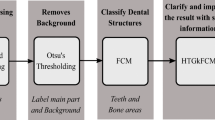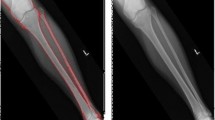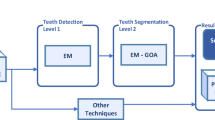Abstract
Dental X-ray image segmentation has an important role in practical dentistry and is widely used in the discovery of odontological diseases, tooth archeology and in automated dental identification systems. Enhancing the accuracy of dental segmentation is the main focus of researchers, involving various machine learning methods to be applied in order to gain the best performance. However, most of the currently used methods are facing problems of threshold, curve functions, choosing suitable parameters and detecting common boundaries among clusters. In this paper, we will present a new semi-supervised fuzzy clustering algorithm named as SSFC-FS based on Interactive Fuzzy Satisficing for the dental X-ray image segmentation problem. Firstly, features of a dental X-Ray image are modeled into a spatial objective function, which are then to be integrated into a new semi-supervised fuzzy clustering model. Secondly, the Interactive Fuzzy Satisficing method, which is considered as a useful tool to solve linear and nonlinear multi-objective problems in mixed fuzzy-stochastic environment, is applied to get the cluster centers and the membership matrix of the model. Thirdly, theoretically validation of the solutions including the convergence rate, bounds of parameters, and the comparison with solutions of other relevant methods is performed. Lastly, a new semi-supervised fuzzy clustering algorithm that uses an iterative strategy from the formulae of solutions is designed. This new algorithm was experimentally validated and compared with the relevant ones in terms of clustering quality on a real dataset including 56 dental X-ray images in the period 2014–2015 of Hanoi Medial University, Vietnam. The results revealed that the new algorithm has better clustering quality than other methods such as Fuzzy C-Means, Otsu, eSFCM, SSCMOO, FMMBIS and another version of SSFC-FS with the local Lagrange method named SSFC-SC. We also suggest the most appropriate values of parameters for the new algorithm.



Similar content being viewed by others
Abbreviations
- Spatial constraints:
-
Refer to the conditions regarding dental structure of a dental X-ray image. Some similar terms are: “spatial features”, “dental feature”
- FCM:
-
Fuzzy C-Means
- SSFC-SC:
-
Semi-Supervised Fuzzy Clustering algorithm with Spatial Constraints
- FS:
-
Fuzzy Satisficing method
- LA:
-
Lagrange method
- SSFC-FS:
-
Semi-Supervised Fuzzy Clustering algorithm with Spatial Constraints using Fuzzy Satisficing method
- Membership matrix/degrees:
-
Refer to the level that a data point belongs to a given cluster
- eSFCM:
-
Semi-supervised Entropy regularized Fuzzy Clustering
- LBP:
-
Local Binary Patterns
- RGB:
-
Red-Green-Blue
- DB:
-
Davies-Bouldin validity index
- SSWC:
-
Simplified Silhouete Width Criterion validity index
- PBM:
-
A validity index
- IFV:
-
A spatial validity index
- BH:
-
Ball and Hall index
- VCR:
-
Calinski - Harabasz index
- BR:
-
The Banfeld - Raftery index
- TRA:
-
Difference-like index
- SSCMOO:
-
Semi-Supervised Clustering technique using Multi- Objective Optimization
- FMMBIS:
-
Fuzzy Mathematical Morphology for Biological Image Segmentation
References
Ahonen T, Hadid A, Pietikainen M (2006) Face description with local binary patterns: Application to face recognition. IEEE Trans Pattern Anal Mach Intell 28(12):2037–2041
Alok AK, Saha S, Ekbal A (2015) A new semi-supervised clustering technique using multi-objective optimization. Appl Intell 43(3):633–661
Bezdek JC, Ehrlich R (1984) FCM: The fuzzy c-means clustering algorithm. Comput Geosci 10(2):191–203
Bouchachia A, Pedrycz W (2006) Data clustering with partial supervision. Data Min Knowl Disc 12 (1):47–78
Caponetti L, Castellano G, Basile MT, Corsini V (2014) Fuzzy mathematical morphology for biological image segmentation. Appl Intell 41(1):117–127
Caramia M, Dell’Olmo P (2008) Multi-objective management in freight logistics: Increasing capacity, service level and safety with optimization algorithms. Springer Science & Business Media
Ghazali KH, Mustafa MM, Hussain A, Bandar MEC, Kuantan G (2007) Feature Extraction technique using SIFT keypoints descriptors. In: The international conference on electrical and engineering and informatics institut technology , pp 17–19
Jiayin K, Zhicheng J (2010) Dental plaque segmentation and quantification using histogram-aided fuzzy c-means algorithm. In: Control conference (CCC), 2010 29th chinese (pp. 3068-3071). IEEE
Kang JY, Min LQ, Luan QX, Li X, Liu JZ (2007) Dental plaque quantification using FCM-based classification in HSI color space. In: Wavelet analysis and pattern recognition, 2007. ICWAPR’07. International conference on (vol. 1, pp. 78-81). IEEE
Kang J, Li X, Luan Q, Liu J, Min L (2006) Dental plaque quantification using cellular neural network-based image segmentation. In: Intelligent computing in signal processing and pattern recognition (pp. 797-802). Springer berlin heidelberg
Kang J, Min L, Luan Q, Li X, Liu J (2009) Novel modified fuzzy c-means algorithm with applications. Digital Signal Process 19(2):309–319
Kondo T, Ong SH, Foong KW (2004) Tooth segmentation of dental study models using range images. IEEE Trans Med Imaging 23(3):350–362
Kumar Y, Janardan R, Larson B, Moon J (2011) Improved segmentation of teeth in dental models. Comput-Aided Des Applic 8(2):211–224
Lai YH, Lin PL (2008) Effective segmentation for dental X-ray images using texture-based fuzzy inference system. In: Advanced concepts for intelligent vision systems (pp. 936-947). Springer berlin heidelberg
Li S, Fevens T, KrzyŻak A, Li S (2006) An automatic variational level set segmentation framework for computer aided dental X-rays analysis in clinical environments. Comput Med Imaging Graph 30(2):65–74
Li S, Fevens T, KrzyŻak A (2006) Automatic clinical image segmentation using pathological modeling, PCA and SVM. Eng Appl Artif Intell 19(4):403–410
Mahoor MH, Abdel-Mottaleb M (2005) Classification and numbering of teeth in dental bitewing images. Pattern Recogn 38(4):577–586
Mathworks (2015) Dental Image Segmentation. Available at: https://www.mathworks.com/matlabcentral/fileexchange/52762-semi-supervised-fuzzy-clustering-with-fuzzy-satisficing (Accessed on: Aug 31, 2015)
Mohan C, Nguyen HT (2001) An interactive satisficing method for solving multiobjective mixed fuzzy-stochastic programming problems. Fuzzy Sets Syst 117(1):61–79
Narkhede HP (2013) Review of image segmentation techniques. Int J Sci Mod Eng 1(5461):28
Nayak J, Naik B, Behera HS (2015) Fuzzy C-Means (FCM) Clustering Algorithm A Decade Review from 2000 to 2014. In: Computational intelligence in data mining-volume 2 (pp. 133-149). Springer India
Ngo LT, Mai DS, Pedrycz W (2015) Semi-supervising Interval Type-2 Fuzzy C-Means clustering with spatial information for multi-spectral satellite image classification and change detection. Comput Geosci 83:1–16
Thanh NH (2002) PRELIM–An interactive computer package for solving realistic optimization problems in fuzzy environment. Proceedings of VJFUZZY’98: Vietnam −Japan bilateral symposium on fuzzy systems and applications 652–659
Nomir O, Abdel-Mottaleb M (2005) A system for human identification from X-ray dental radiographs. Pattern Recogn 38(8):1295–1305
Nomir O, Abdel-Mottaleb M (2007) Human identification from dental X-ray images based on the shape and appearance of the teeth. IEEE Trans Inf Forensics Secur 2(2):188–197
Otsu N (1975) A threshold selection method from gray-level histograms. Automatica 11(285-296):23–27
Pham TD, Eisenblätter U, Golledge J, Baune BT, Berger K (2009) Segmentation of medical images using geo-theoretic distance matrix in fuzzy clustering. In: Image processing (ICIP), 2009 16th IEEE international conference on (pp. 3369-3372). IEEE
Perkgoz C, Sakawa M, Kato K, Katagiri H (2005) An interactive fuzzy satisficing method for multiobjective stochastic integer programming problems through a probability maximization model. Asia Pacific Manag Rev 10 (1):29
Rad AE, Rahim MS M, Norouzi A Level Set and Morphological Operation Techniques in Application of Dental Image Segmentation
Rad AE, Mohd Rahim MS, Rehman A, Altameem A, Saba T (2013) Evaluation of current dental radiographs segmentation approaches in computer-aided applications. IETE Tech Rev 30(3):210–222
Said EH, Nassar DEM, Fahmy G, Ammar HH (2006) Teeth segmentation in digitized dental X-ray films using mathematical morphology. IEEE Trans Inf Forensics Secur 1(2):178–189
Sakawa M, Matsui T (2012) An Interactive Fuzzy Satisficing Method for Multiobjective Stochastic Integer Programming with Simple Recourse
Sato-Ilic M, Jain LC (2006) Introduction to fuzzy clustering. In: Innovations in fuzzy clustering (pp. 1-8). Springer berlin heidelberg
Setarehdan SK, Singh S (eds.) (2012) Advanced algorithmic approaches to medical image segmentation: state-of-the-art applications in cardiology, neurology, mammography and pathology Springer Science & Business Media
Shah S, Abaza A, Ross A, Ammar H (2006) Automatic tooth segmentation using active contour without edges. In: Biometric consortium conference, 2006 biometrics symposium: Special session on research at the (pp. 1-6). IEEE
Stolojescu-CriŞan C, Holban Ş (2013) A comparison of X-Ray image segmentation techniques. Advances Electr Comput Eng Eng 13(3)
Vendramin L, Campello RJ, Hruschka ER (2010) Relative clustering validity criteria: A comparative overview. Stat Anal Data Min: The ASA Data Sci J 3(4):209–235
Xu X, Xu S, Jin L, Song E (2011) Characteristic analysis of Otsu threshold and its applications. Pattern Recogn Lett 32(7):956–961
Yasunori E, Yukihiro H, Makito Y, Sadaaki M (2009) On semi-supervised fuzzy c-means clustering. In: Fuzzy systems, 2009. FUZZ-IEEE 2009. IEEE international conference on (pp. 1119-1124). IEEE
Yin X, Shu T, Huang Q (2012) Semi-supervised fuzzy clustering with metric learning and entropy regularization. Knowl-Based Syst 35:304–311
Zhao M, Ma L, Tan W, Nie D (2006) Interactive tooth segmentation of dental models. In: Engineering in medicine and biology society, 2005. IEEE-EMBS 2005. 27th annual international conference of the (pp. 654-657). IEEE
Zhou J, Abdel-Mottaleb M (2005) A content-based system for human identification based on bitewing dental X-ray images. Pattern Recogn 38(11):2132–2142
Tee CS (2008) Feature selection for content-based image retrieval using statistical discriminant analysis Doctoral dissertation, Universiti Teknologi Malaysia, Faculty of Computer Science and Information System
Acknowledgments
The authors are greatly indebted to the editor-in-chief, Prof. Moonis Ali and anonymous reviewers for their comments and their valuable suggestions that improved the quality and clarity of paper. This research is funded by Vietnam National Foundation for Science and Technology Development (NAFOSTED) under grant number 102.05-2014.01.
Author information
Authors and Affiliations
Corresponding author
Appendix
Appendix
Matlab source codes of all algorithms and experimental data can be found at the URL:
Rights and permissions
About this article
Cite this article
Tuan, T.M., Ngan, T.T. & Son, L.H. A novel semi-supervised fuzzy clustering method based on interactive fuzzy satisficing for dental x-ray image segmentation. Appl Intell 45, 402–428 (2016). https://doi.org/10.1007/s10489-016-0763-5
Published:
Issue Date:
DOI: https://doi.org/10.1007/s10489-016-0763-5




